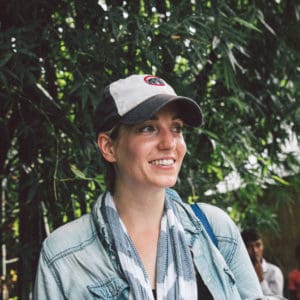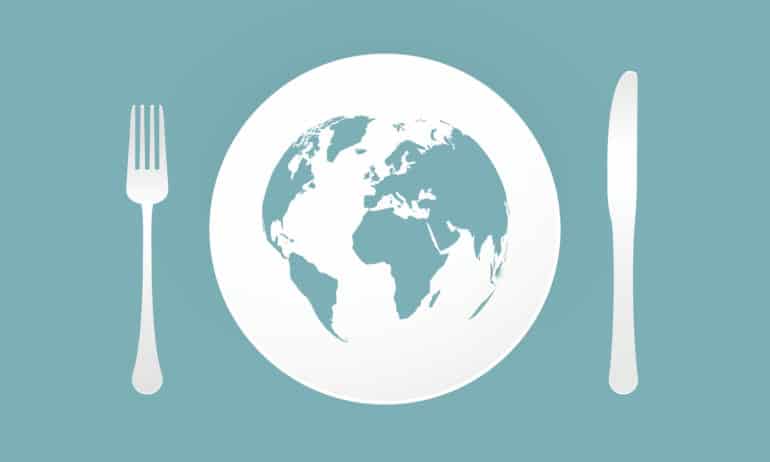M.J. Altman, World Food Program USA’s Editorial Director, will be speaking at the 4th Annual Washington D.C. Food Tank Summit, “Cultivating the Next Generation of Young Food Leaders,” which will be held in partnership with George Washington University, World Resources Institute, the National Farmers Union, Future Farmers of America, and the National Young Farmers Coalition on February 28, 2018.
Altman serves as the Editorial Director at World Food Program USA, a non-profit organization based in Washington, D.C. that supports the mission of the United Nations World Food Programme (WFP). M.J. hosts the organization’s Hacking Hunger podcast, which explores hidden, human stories about hunger and food across the globe. As the granddaughter of Illinois farmers, she brings a personal and journalistic lens to the issues of food security and sustainability. Prior to joining World Food Program USA, M.J. worked at TIME magazine in New York, where she covered a wide range of topics, including social justice and conflict. M.J. has also worked at the Smithsonian Institution, where she researched, wrote, and pitched stories about indigenous history and culture. Her work has been featured on MSNBC, CNN, the Associated Press, and National Geographic, among others.

Food Tank had the opportunity to speak with M.J. about her background, her work with WFP, and her vision for reducing hunger and food waste around the globe.
Food Tank (FT): What originally inspired you to get involved in your work?
M.J. Altman (MA): My background is in journalism. Early in my career, I worked at TIME magazine as a young reporter covering issues such as social justice, environmentalism, and conflict. Food security encompasses all of these issues, and it’s something that brings all people together. We all rely on food to live, and solving hunger means tackling some of the most pernicious social issues such as poverty, gender inequality, disease, and conflict.
FT: How are you helping to build a better food system?
MA: I believe anyone who supports WFP in some capacity—whether it’s writing to their lawmakers, making a donation, or even simply sharing a story with their friends and loved ones—is helping build a better food system by empowering the most vulnerable with good nutrition. As Editorial Director at World Food Program USA, my job is to help share the stories of those on the front lines of hunger—whether it’s a smallholder farmer, an impoverished parent, or a child displaced by war—and highlight ongoing efforts to achieve global food security once and for all. I truly believe in this mission, and it’s an honor to help bring awareness and inspire others to get involved. The UN has set an ambitious goal to achieve Zero Hunger by 2030, meaning that everyone has access to enough nourishing food to survive and thrive. It’s entirely possible if we can get enough people, governments, companies, and innovators involved.
FT: What’s the most pressing issue in food and agriculture that you’d like to see solved?
MA: That’s an easy one for me—food waste! Until joining World Food Program USA, I never knew that the world collectively wastes one-third of all the food we grow. I was also surprised to learn what food waste looks like in poor countries. It’s not the food that rots in the fridge or gets left uneaten on the plate. For many of the farmers that WFP serves, the food waste happens right after harvest. They don’t have airtight storage to prevent bugs and mold from infesting their crops. And this mold can actually lead to cancer, a major health issue in low-income countries.
FT: What innovations in food and agriculture are you most excited about?
MA: That is a really hard question. One of my coworkers at World Food Program USA jokingly calls me the innovation junkie, because I’m endlessly fascinated by recent innovations and how much they’re changing how people eat. I’m not just talking about high-tech innovations like iris scan technology and cellphone hunger-mapping; I’m also talking about really low-tech innovations like airtight silos to prevent post-harvest food loss, or even innovations in practice like the idea of a homegrown school meal, which entails investing in smallholder farmers that grow fresh, diverse crops to source a local school meal, thus creating a sustainable supply chain that delivers nutrition and provides a reliable market.
I’m also fascinated with the evolution of delivering humanitarian food assistance in the form of a debit card or using drones, even drones made out of cardboard. In 2016, WFP actually launched a startup incubator to support food-related innovation called the Innovation Accelerator. It’s based in Berlin and accepts proposals on a rolling basis from both the public and private sectors. One of the Innovation Accelerator’s most successful launches is ShareTheMeal, a mobile app that won the SXSW Interactive Innovation Award and a Webby Award and has so far raised enough money to deliver 20 million meals. It’s a really cool app that brings the experience of sharing a meal to life in a way that traditional giving sometimes can’t.
FT: What is one small change every person can make in their daily lives to make a big difference?
MA: I’m going to go back to my previous answer and reiterate food waste. As consumers, we need to be far more conscious about the amount of food that we’re throwing away. Obviously, I’m biased, but people should join WFP’s movement, whether that means using the ShareTheMeal app, sharing stories on social media, or writing to your lawmakers on WFP’s behalf. WFP is the world’s leading humanitarian agency fighting global hunger, and they know what they’re doing. Donating just US$1 can provide a school meal to four hungry children. Just US$50 could feed a child for an entire school year. And there are so many ways to support our cause; starting your own fundraiser, having your employer match a gift, or texting to donate.
FT: What is the best opportunity for young or aspiring farmers and entrepreneurs to get a foothold in America’s agricultural future?
MA: I think it starts by engaging with communities like this one, where different people of all ages, backgrounds, and disciplines can come together—in person—to share their ideas and insights. And given today’s global food chain, America’s agricultural future is inextricably connected to farmers and consumers across the globe.
FT: How can we best stimulate young people’s curiosity about food and agriculture and encourage their participation in building healthier food systems?
MA: Powerful, relatable storytelling. It’s too easy, especially in the United States, to forget where our food comes from and the many hands it must pass through to end up on our plates. I think if we can uncover these hidden, human stories, we can spark the curiosity of the next generation and encourage young people to get involved in building healthier food systems.
The D.C. Food Tank Summit is SOLD OUT but tickets remain for our next two Summits. Register HERE for the Seattle Food Tank Summit, Growing Food Policy on March 17. Register HERE for the Boston Food Tank Summit, Exploring the Paradox of Hunger and Obesity on April 19. These events will sell out – register today!












